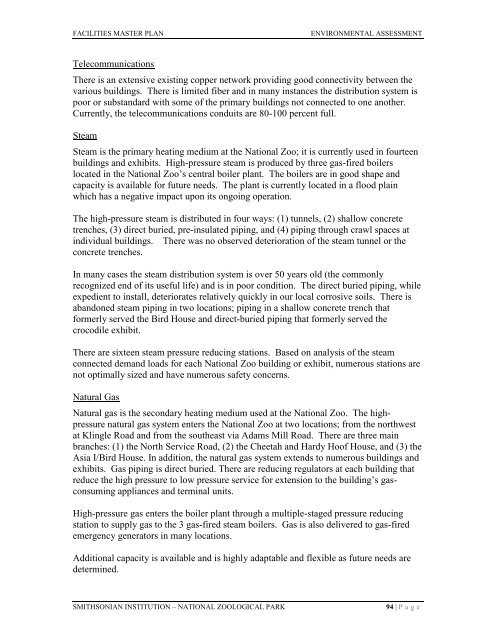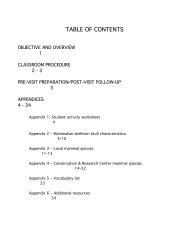facilities renewal master plan - National Zoo - Smithsonian Institution
facilities renewal master plan - National Zoo - Smithsonian Institution
facilities renewal master plan - National Zoo - Smithsonian Institution
Create successful ePaper yourself
Turn your PDF publications into a flip-book with our unique Google optimized e-Paper software.
FACILITIES MASTER PLAN ENVIRONMENTAL ASSESSMENT<br />
Telecommunications<br />
There is an extensive existing copper network providing good connectivity between the<br />
various buildings. There is limited fiber and in many instances the distribution system is<br />
poor or substandard with some of the primary buildings not connected to one another.<br />
Currently, the telecommunications conduits are 80-100 percent full.<br />
Steam<br />
Steam is the primary heating medium at the <strong>National</strong> <strong>Zoo</strong>; it is currently used in fourteen<br />
buildings and exhibits. High-pressure steam is produced by three gas-fired boilers<br />
located in the <strong>National</strong> <strong>Zoo</strong>’s central boiler <strong>plan</strong>t. The boilers are in good shape and<br />
capacity is available for future needs. The <strong>plan</strong>t is currently located in a flood plain<br />
which has a negative impact upon its ongoing operation.<br />
The high-pressure steam is distributed in four ways: (1) tunnels, (2) shallow concrete<br />
trenches, (3) direct buried, pre-insulated piping, and (4) piping through crawl spaces at<br />
individual buildings. There was no observed deterioration of the steam tunnel or the<br />
concrete trenches.<br />
In many cases the steam distribution system is over 50 years old (the commonly<br />
recognized end of its useful life) and is in poor condition. The direct buried piping, while<br />
expedient to install, deteriorates relatively quickly in our local corrosive soils. There is<br />
abandoned steam piping in two locations; piping in a shallow concrete trench that<br />
formerly served the Bird House and direct-buried piping that formerly served the<br />
crocodile exhibit.<br />
There are sixteen steam pressure reducing stations. Based on analysis of the steam<br />
connected demand loads for each <strong>National</strong> <strong>Zoo</strong> building or exhibit, numerous stations are<br />
not optimally sized and have numerous safety concerns.<br />
Natural Gas<br />
Natural gas is the secondary heating medium used at the <strong>National</strong> <strong>Zoo</strong>. The highpressure<br />
natural gas system enters the <strong>National</strong> <strong>Zoo</strong> at two locations; from the northwest<br />
at Klingle Road and from the southeast via Adams Mill Road. There are three main<br />
branches: (1) the North Service Road, (2) the Cheetah and Hardy Hoof House, and (3) the<br />
Asia I/Bird House. In addition, the natural gas system extends to numerous buildings and<br />
exhibits. Gas piping is direct buried. There are reducing regulators at each building that<br />
reduce the high pressure to low pressure service for extension to the building’s gasconsuming<br />
appliances and terminal units.<br />
High-pressure gas enters the boiler <strong>plan</strong>t through a multiple-staged pressure reducing<br />
station to supply gas to the 3 gas-fired steam boilers. Gas is also delivered to gas-fired<br />
emergency generators in many locations.<br />
Additional capacity is available and is highly adaptable and flexible as future needs are<br />
determined.<br />
SMITHSONIAN INSTITUTION – NATIONAL ZOOLOGICAL PARK 94 | P a g e

















